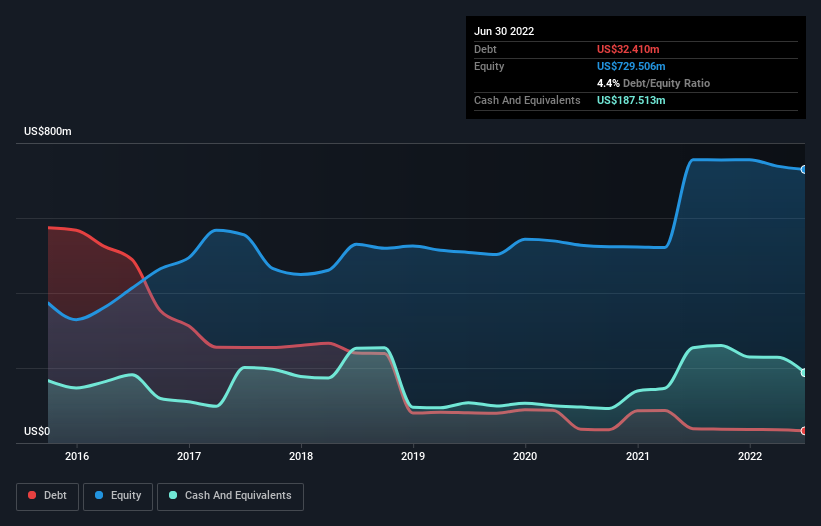Is Clean Energy Fuels (NASDAQ:CLNE) Using Too Much Debt?
Legendary fund manager Li Lu (who Charlie Munger backed) once said, 'The biggest investment risk is not the volatility of prices, but whether you will suffer a permanent loss of capital.' When we think about how risky a company is, we always like to look at its use of debt, since debt overload can lead to ruin. We note that Clean Energy Fuels Corp. (NASDAQ:CLNE) does have debt on its balance sheet. But the more important question is: how much risk is that debt creating?
When Is Debt A Problem?
Debt and other liabilities become risky for a business when it cannot easily fulfill those obligations, either with free cash flow or by raising capital at an attractive price. Ultimately, if the company can't fulfill its legal obligations to repay debt, shareholders could walk away with nothing. However, a more common (but still painful) scenario is that it has to raise new equity capital at a low price, thus permanently diluting shareholders. Of course, plenty of companies use debt to fund growth, without any negative consequences. When we think about a company's use of debt, we first look at cash and debt together.
Check out our latest analysis for Clean Energy Fuels
What Is Clean Energy Fuels's Net Debt?
You can click the graphic below for the historical numbers, but it shows that Clean Energy Fuels had US$32.4m of debt in June 2022, down from US$38.3m, one year before. But it also has US$187.5m in cash to offset that, meaning it has US$155.1m net cash.
How Healthy Is Clean Energy Fuels' Balance Sheet?
Zooming in on the latest balance sheet data, we can see that Clean Energy Fuels had liabilities of US$126.0m due within 12 months and liabilities of US$78.7m due beyond that. Offsetting this, it had US$187.5m in cash and US$90.4m in receivables that were due within 12 months. So it can boast US$73.1m more liquid assets than total liabilities.
This surplus suggests that Clean Energy Fuels has a conservative balance sheet, and could probably eliminate its debt without much difficulty. Simply put, the fact that Clean Energy Fuels has more cash than debt is arguably a good indication that it can manage its debt safely. There's no doubt that we learn most about debt from the balance sheet. But it is future earnings, more than anything, that will determine Clean Energy Fuels's ability to maintain a healthy balance sheet going forward. So if you want to see what the professionals think, you might find this free report on analyst profit forecasts to be interesting.
Over 12 months, Clean Energy Fuels reported revenue of US$359m, which is a gain of 61%, although it did not report any earnings before interest and tax. Shareholders probably have their fingers crossed that it can grow its way to profits.
So How Risky Is Clean Energy Fuels?
Although Clean Energy Fuels had an earnings before interest and tax (EBIT) loss over the last twelve months, it generated positive free cash flow of US$17m. So taking that on face value, and considering the net cash situation, we don't think that the stock is too risky in the near term. We think its revenue growth of 61% is a good sign. There's no doubt fast top line growth can cure all manner of ills, for a stock. The balance sheet is clearly the area to focus on when you are analysing debt. But ultimately, every company can contain risks that exist outside of the balance sheet. These risks can be hard to spot. Every company has them, and we've spotted 1 warning sign for Clean Energy Fuels you should know about.
Of course, if you're the type of investor who prefers buying stocks without the burden of debt, then don't hesitate to discover our exclusive list of net cash growth stocks, today.
Have feedback on this article? Concerned about the content? Get in touch with us directly. Alternatively, email editorial-team (at) simplywallst.com.
This article by Simply Wall St is general in nature. We provide commentary based on historical data and analyst forecasts only using an unbiased methodology and our articles are not intended to be financial advice. It does not constitute a recommendation to buy or sell any stock, and does not take account of your objectives, or your financial situation. We aim to bring you long-term focused analysis driven by fundamental data. Note that our analysis may not factor in the latest price-sensitive company announcements or qualitative material. Simply Wall St has no position in any stocks mentioned.
Join A Paid User Research Session
You’ll receive a US$30 Amazon Gift card for 1 hour of your time while helping us build better investing tools for the individual investors like yourself. Sign up here

 Yahoo Finance
Yahoo Finance 
